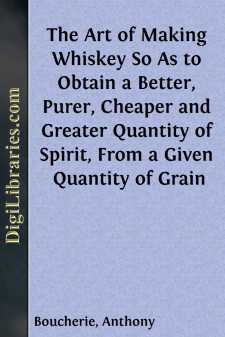Categories
- Antiques & Collectibles 13
- Architecture 36
- Art 48
- Bibles 22
- Biography & Autobiography 813
- Body, Mind & Spirit 142
- Business & Economics 28
- Children's Books 14
- Children's Fiction 11
- Computers 4
- Cooking 94
- Crafts & Hobbies 4
- Drama 346
- Education 46
- Family & Relationships 57
- Fiction 11829
- Games 19
- Gardening 17
- Health & Fitness 34
- History 1377
- House & Home 1
- Humor 147
- Juvenile Fiction 1873
- Juvenile Nonfiction 202
- Language Arts & Disciplines 88
- Law 16
- Literary Collections 686
- Literary Criticism 179
- Mathematics 13
- Medical 41
- Music 40
- Nature 179
- Non-Classifiable 1768
- Performing Arts 7
- Periodicals 1453
- Philosophy 64
- Photography 2
- Poetry 896
- Political Science 203
- Psychology 42
- Reference 154
- Religion 513
- Science 126
- Self-Help 84
- Social Science 81
- Sports & Recreation 34
- Study Aids 3
- Technology & Engineering 59
- Transportation 23
- Travel 463
- True Crime 29
The Art of Making Whiskey So As to Obtain a Better, Purer, Cheaper and Greater Quantity of Spirit, From a Given Quantity of Grain
Categories:
Description:
Excerpt
CHAPTER I.
OF SPIRITUOUS LIQUORS, OR SPIRITS.
Spirituous liquors are the produce of vinous ones, obtained by the distillation of these last. The art of making wine is of the remotest antiquity, since it is attributed to Noah; but that of distilling it, so as to extract its most spirituous part, dates only from the year 1300. Arnand de Villeneuve was the inventor of it, and the produce of his Still appeared so marvellous, that it was named Aqua-Vitæ, or Water of Life, and has ever since continued under that denomination in France; Voltaire and reason say that it might, with far more propriety, be called Aqua-Mortis, or Water of Death.
This liquor, called in English, Brandy, received from the learned the name of Spirit of Wine; time improved the art of making it still stronger by concentration, and in that state it is called Alcohol.
All spirit is the distilled result of a wine, either of grapes, other fruits, or grains; it is therefore necessary to have either wine, or any vinous liquor, in order to obtain spirits.
The art of extracting wine from the juice of the grape, not being the object of this book, I shall confine myself to what is necessary and useful to the distillers of whiskey; it is therefore of the vinous liquor extracted from grains, that I am going to speak.
The formation of that kind of liquor is founded upon a faculty peculiar to grains, which the learned chymist, Fourcroy, has called saccharine fermentation. Sugar itself does not exist in gramineous substances; they only contain its elements, or first principles, which produce it. The saccharine fermentation converts those elements into sugar, or at least into a saccharine matter; and when this is developed, it yields the eminent principle of fermentation, without which there exists no wine, and consequently no spirit.
Grains yield two kinds of vinous liquors, of which the distiller makes spirit, and the brewer a sort of wine, called beer. From a comparison of the processes employed to obtain these two results, it will be found that the brewer's art has attained a higher degree of perfection than that of the distiller. They both have for their object to obtain a vinous liquor; but that of the brewer is, in reality, a sort of wine to which he gives, at pleasure, different degrees of strength; while that of the distiller is scarcely vinous, and cannot be made richer. I will give a succinct exposition of their two processes in order that they may be compared.
OF THE ART OF BREWING.
The art of brewing consists:
1st. In the sprouting of a proportion of grain, chiefly barley. This operation converts into a saccharine matter, the elements of that same substance already existing in grains.
2dly. In preparing the wort. For that operation, the grain, having been previously ground, is put into a vat, which is half filled up with water; the rest is filled up at three different times with hot water—the first at 100°, the second at 150°, and the third at 212°, which is boiling water. The mixture is strongly stirred each time that it is immersed. By this infusion, the water lays hold of the sweet principles contained in the grain.
3dly. The wort thus prepared, the liquor is filtrated, in order to separate it from the grain, and then boiled until reduced to one half, in order to concentrate it to the degree of strength desired. In that state, 40 gallons of wort contain the saccharine principles of 200 wt. of grain.
4thly. The wort, thus concentrated, is drawn off in barrels, which are kept in a temperature of 80° or 85°. The yeast is thrown into it to establish the fermentation, and in a short time beer is made, more or less strong, according to the degree of concentration, and more or less bitter, according to the greater or lesser proportion of hops put into it.
Such are, in a concise view, the proceedings of the brewer. Let us proceed to those of the distiller of whiskey.
Whiskey is made either with rye, barley, or Indian corn....


